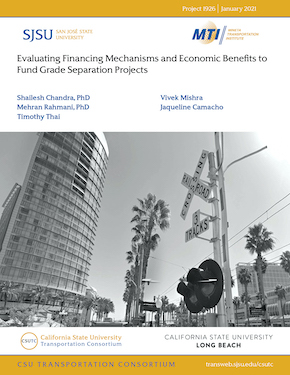- 408-924-7560
- mineta-institute@sjsu.edu
- Donate
Evaluating Financing Mechanisms and Economic Benefits to Fund Grade Separation Projects
Investment in transportation infrastructure projects generates benefits, both direct and indirect. While emissions reductions, crash reductions, and travel time savings are prominent direct benefits, there are indirect benefits in the form of real estate enhancements that could pay off debt or loan incurred in the improvement of the infrastructure itself. Studies have shown that improvements associated with rail transportation (such as station upgrades) trigger an increase in the surrounding real estate values, increasing both the opportunity for monetary gains and, ultimately, property tax collections. There is plenty of available guidance that provides blueprints for benefits calculations for operational improvements in rail transportation. However, resources are quite limited in the analysis of benefits that accrue from the separation of railroad at-grade crossings. Understanding the impact of separation in a neighborhood with high employment or population could generate revenues through increased tax collections. In California, the research need is further amplified by a lack of guidance from the California Public Utilities Commission (CPUC) on at-grade crossing for separation based on revenue generated. There is a critical need to understand whether grade separation projects could impact neighboring real estate values that could potentially be used to fund such separations. With COVID-19, as current infrastructure spending in California is experiencing a reboot, an approach more oriented to benefits and costs for railroad at-grade separation should be explored. Thus, this research uses a robust benefits-to-cost analysis (BCA) to probe the economic impacts of railroad at-grade separation projects. The investigation is carried out across twelve railroad-highway at-grade crossings in California. These crossings are located at Francisquito Ave., Willowbrook/Rosa Parks Station, Sassafras St., Palm St., Civic Center Dr., L St., Spring St. (North), J St., E St., H St., Parkmoor West, and Nursery Ave. The authors found that a majority of the selected at-grade crossings analyzed accrue high benefits-to-cost (BC) ratios from travel time savings, safety improvements, emissions reductions, and potential revenue generated if property taxes are collected and used to fund such separation projects. The analysis shows that with the estimated BC ratios, the railroad crossing at Nursery Ave. in Fremont, Palm St. in San Diego, and H St. in Chula Vista could be ideal candidates for separation. The methodology presented in this research could serve as a handy reference for decision-makers selecting one or more at-grade crossings for the separation considering economic outputs and costs.
SHAILESH CHANDRA
Dr. Chandra is an associate professor in the Department of Civil Engineering and Construction Engineering Management at California State University, Long Beach (CSULB). He obtained his MS and PhD in civil engineering from Texas A&M University in 2009 and 2012. Dr. Chandra has more than twelve years of transportation research experience focused on transport connectivity, transportation economics, accessibility, urban freight, and sustainability. He has been a principal investigator (PI) for several projects funded by various transportation agencies, including the California Department of Transportation (Caltrans) and the United States Department of Transportation (USDOT).
MEHRAN RAHMANI
Dr. Mehran Rahmani is an assistant professor in the Civil Engineering Construction Engineering Management (CECEM) department at California State University, Long Beach. He earned a PhD in Structural and Earthquake Engineering from the University of Southern California (USC) in 2014, an MS in Electrical Engineering (with an emphasis in signal processing) from USC in 2013, and an MS in Structural Engineering from Sharif University of Technology (Iran) in 2009. Before joining CSULB, Dr. Rahmani, a registered Professional Engineer (PE) in California, worked as a Senior Engineer and a Project Engineer in the structural engineering industry from 2014 to 2017.
TIMOTHY THAI
Mr. Thai is an undergraduate student in the Department of Civil Engineering and Construction Engineering Management at CSULB. His research interests include railroad crossings and real estate analysis.
VIVEK MISHRA
Mr. Mishra is a graduate student in the Department of Computer Science and Computer Engineering at CSULB. His research interests relate to computer programming and transportation analysis.
JACQUELINE CAMACHO
Ms. Camacho is an undergraduate student in the Department of Civil Engineering and Construction Engineering Management at CSULB. Her research interests include topics related to crashes at railroad crossings and real estate analysis.
-
Contact Us
San José State University One Washington Square, San Jose, CA 95192 Phone: 408-924-7560 Email: mineta-institute@sjsu.edu






